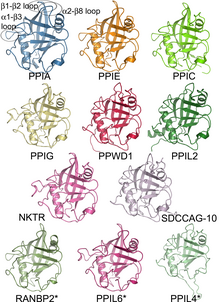
Back عائلة بروتينية Arabic Porodica proteina BS Proteinfamilie German Familia de proteínas Spanish خانواده پروتئین Persian Famille de protéines French Familia de proteínas Galician Fehérjecsalád Hungarian Famili protein ID タンパク質ファミリー Japanese

A protein family is a group of evolutionarily related proteins. In many cases, a protein family has a corresponding gene family, in which each gene encodes a corresponding protein with a 1:1 relationship. The term "protein family" should not be confused with family as it is used in taxonomy.
Proteins in a family descend from a common ancestor and typically have similar three-dimensional structures, functions, and significant sequence similarity.[1][2] Sequence similarity (usually amino-acid sequence) is one of the most common indicators of homology, or common evolutionary ancestry.[3][4] Some frameworks for evaluating the significance of similarity between sequences use sequence alignment methods. Proteins that do not share a common ancestor are unlikely to show statistically significant sequence similarity, making sequence alignment a powerful tool for identifying the members of protein families.[3][4] Families are sometimes grouped together into larger clades called superfamilies based on structural similarity, even if there is no identifiable sequence homology.
Currently, over 60,000 protein families have been defined,[5] although ambiguity in the definition of "protein family" leads different researchers to highly varying numbers.
- ^ "What are protein families? Protein classification". EMBL-EBI. Retrieved 2023-11-14.
- ^ Orengo, Christine; Bateman, Alex (2013). "Introduction". In Orengo, Christine; Bateman, Alex (eds.). Protein Families: Relating Protein Sequence, Structure, and Function. Hoboken, New Jersey: John Wiley & Sons, Inc. pp. vii–xi. doi:10.1002/9781118743089.fmatter. ISBN 9781118743089.
- ^ a b Pearson, William R. (2013). "An Introduction to Sequence Similarity ("Homology") Searching". Current Protocols in Bioinformatics. 3: 3.1.1–3.1.8. doi:10.1002/0471250953.bi0301s42. ISSN 1934-3396. PMC 3820096. PMID 23749753.
- ^ a b Chen, Junjie; Guo, Mingyue; Wang, Xiaolong; Liu, Bin (2018-03-01). "A comprehensive review and comparison of different computational methods for protein remote homology detection". Briefings in Bioinformatics. 19 (2): 231–244. doi:10.1093/bib/bbw108. ISSN 1477-4054. PMID 27881430.
- ^ Kunin, Victor; Cases, Ildefonso; Enright, Anton J.; de Lorenzo, Victor; Ouzounis, Christos A. (2003). "Myriads of protein families, and still counting". Genome Biology. 4 (2): 401. doi:10.1186/gb-2003-4-2-401. ISSN 1474-760X. PMC 151299. PMID 12620116.
© MMXXIII Rich X Search. We shall prevail. All rights reserved. Rich X Search